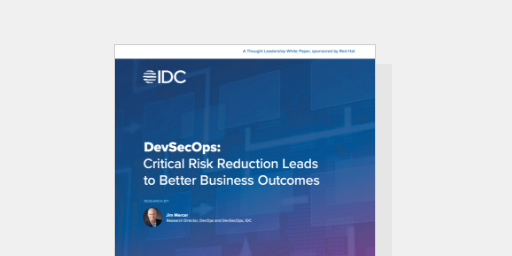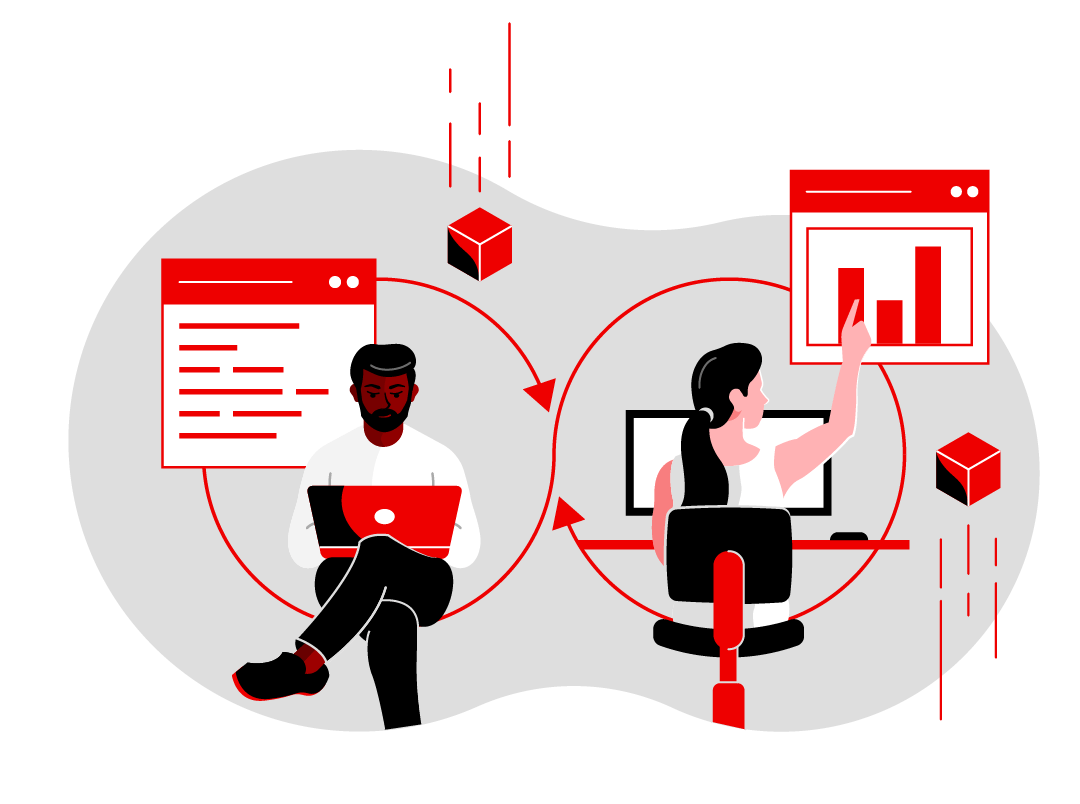Security isn’t an afterthought; it’s continuous
7-minute read |
Listen to this article
Security is often an afterthought. Something that’s done at the end of the development life cycle by the security and IT operations teams. When software updates are made once or maybe twice a year, this process is manageable. But when software developers start opting for shorter, agile software development life cycles that take a few days or even a few hours, this approach to security becomes a hindrance to launching necessary updates or even launching the application quickly to production.
“Top four areas of concern as DevSecOps efforts shift toward the cloud include: data security (45%), cloud security management (36%), supply chain security risks (33%), and protecting public cloud assets (29%).” 1
Data security
Cloud security management
Supply chain security risks
Protecting public cloud assets
By adopting and integrating DevSecOps practices early in the application development life cycle, IT and security teams are able to tackle security challenges across people, processes, and technologies earlier rather than later. They allow security to become a continuous and holistic part of the development life cycle. This agile way of working also allows for improved speed and efficiency, improved security and compliance, improved consistency, repeatability, collaboration, and helps reduce human errors.
Combined, these efforts all ultimately reduce risk and allow for organizations to meet industry security standards for compliance. But how do you get there?
Why DevSecOps matters
With DevSecOps, faster can be
achieved
safely
As enterprises increasingly run more workloads across hybrid environments, including bare metal, virtual machines, private and public clouds, they face increasingly complex and challenging security and compliance concerns. Spreading data across workloads adds another layer of complexity to existing security challenges like container security, insider threats, or malware.
DevSecOps helps IT and security teams tackle security issues across people, processes, and technologies. Specifically, DevSecOps helps:
- Improve safety and minimize risks by removing more security vulnerabilities early in the application development and infrastructure life cycle
- Enhance efficiency and speed of DevOps release cycles by removing legacy security practices and tools, and using automation and standardization
- Lessen risk and increase visibility by implementing security gates early in the application development and infrastructure life cycle
Security teams not only need to balance risk with mitigation, but also manage the security and compliance issues of multiple cloud providers and rapidly changing IT standards. As a result, achieving hybrid cloud security critically relies on the participation and collaboration of teams across an enterprise.
“DevOps teams who take on more security ownership in collaboration with the security groups show greater DevSecOps maturity. The key is shared ownership across development, IT operations, and information security.” 2
Open source and open standards are the critical foundation of our open hybrid cloud strategy, as the open element provided by open source enables applications and data to consistently move from one environment to another. However, using unmanaged community software can leave organizations vulnerable to attacks.
Our path to open hybrid cloud security and DevSecOps offers trusted and security-focused solutions that help businesses focus on building, managing, and controlling their hybrid environments, implementing an automation strategy, and developing robust applications with DevSecOps practices.
The Red Hat approach to DevSecOps
Integrate DevSecOps practices in the
app dev lifecycle early, often, and
continuously
DevSecOps is critical to enterprises looking to rapidly develop applications without sacrificing security. However, DevSecOps is about more than the application life cycle. Our approach integrates security at every phase of the life cycle and technology stack along with Red Hat’s ecosystem of partners.
Build a security-focused hybrid cloud
Successfully implementing DevSecOps begins before the application pipeline. As a first step, organizations should make sure their applications and infrastructure are running on software that has built-in security tools and features.
Red Hat open source software is developed with a software supply chain security process, which provides the flexibility needed to move workloads to any footprint that works best for your business, while reducing exposure to vulnerabilities and attacks. Red Hat also includes static code analysis of source code, software provenance, extensive quality assurance and regression testing, hardening, distribution through a secured channel, and continuous security updates for all the packages included in Red Hat products.
Red Hat Enterprise Linux® provides the foundational security from which customers can reliably scale their critical applications and roll out emerging technologies consistently across bare-metal, virtual, container, and all types of cloud environments.
With the foundational security provided by Red Hat Enterprise Linux, the layered products that run on top, such as Red Hat OpenShift®, benefit by inheriting the security technologies provided by Red Hat Enterprise Linux. Red Hat delivers the same trusted Linux content packaged as Linux containers. With Red Hat Universal Base Images, customers can take advantage of the greater reliability, security features, and performance of Red Hat container images wherever Open Container Initiative (OCI)-compliant Linux containers run.
Manage and control your security-focused hybrid cloud
One key way to manage and control a hybrid environment, which includes both traditional and containerized environments, at scale is to use a consistent automation strategy across application development, security operations, and infrastructure operations for improved security and compliance. When companies adopt a consistent automation strategy for their hybrid cloud, they gain key aspects of improved security and compliance.
Security in application development using DevSecOps practices
Once organizations have improved security by building their hybrid cloud on a foundation with integrated security and implemented a consistent automation strategy across the organization to manage and control their hybrid environments, they should continue to focus on security by extending their automation to the application lifecycle and adopting DevSecOps practices early in the development and infrastructure lifecycle.
45%
“45% of the respondents identified faster development and deployments while maintaining security as a principal driver.“ 3
DevSecOps with Red Hat solutions is about helping our customers with building security early in their application pipeline and deploying and running applications using DevSecOps practices in both traditional and containerized environments. This is not only a technology change, but also a culture and people process change too.
55%
“55% of DevSecOps leaders indicated that building a culture of shared ownership between application development and security teams was critical.“ 4
Together with our partners, we offer the tools and services to build a comprehensive DevSecOps ecosystem, along with the expertise and ability to deliver a robust portfolio to build, deploy, and run security-focused applications across an open hybrid cloud. The result? Improved processes, faster application development without sacrificing security, a culture of collaboration, and reduced risk for your business and ultimately, your customers.
1: IDC White Paper, sponsored by Red Hat. “DevSecOps: Critical Risk Reduction Leads to Better Business Outcomes.” #US48346521, page 6, December, 2021.
2: IDC White Paper, sponsored by Red Hat. “DevSecOps: Critical Risk Reduction Leads to Better Business Outcomes.” #US48346521, page 4, December, 2021.
3: IDC White Paper, sponsored by Red Hat. “DevSecOps: Critical Risk Reduction Leads to Better Business Outcomes.” #US48346521, page 5, December, 2021.
4: IDC White Paper, sponsored by Red Hat. “DevSecOps: Critical Risk Reduction Leads to Better Business Outcomes.” #US48346521, page 15, December, 2021.


